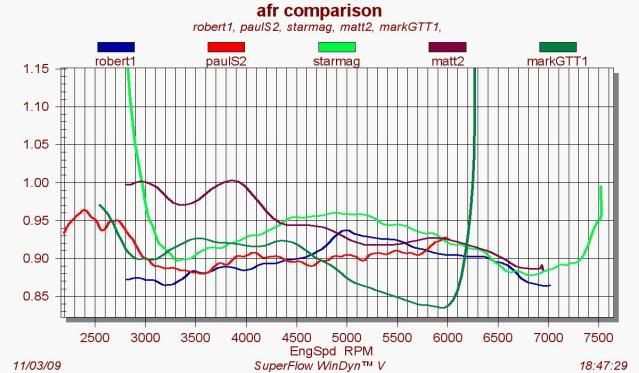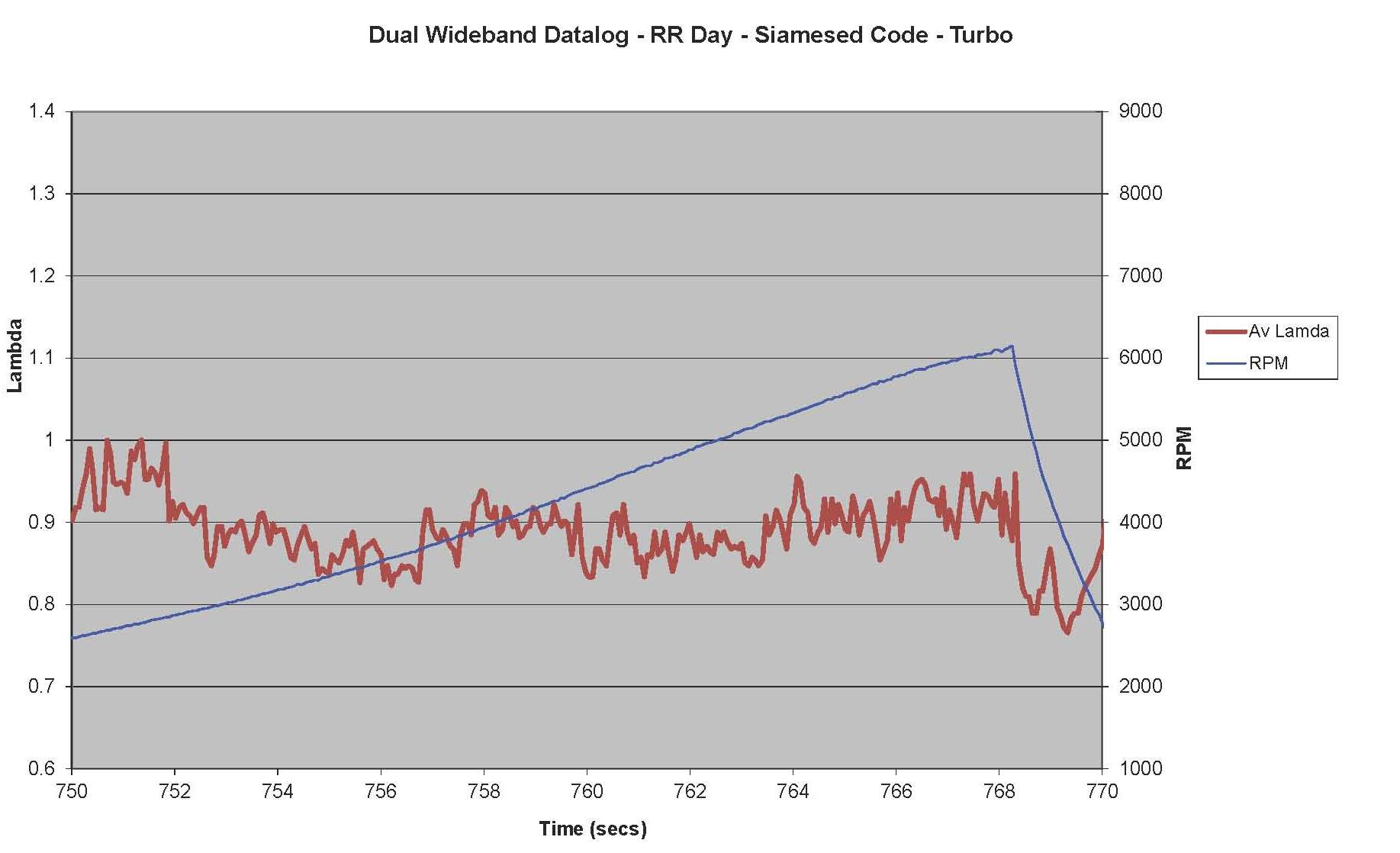| Page: |
| Home > A-Series EFI / Injection > Dual wideband and other stuff | |||||||
|
3588 Posts Member #: 655 Post Whore Northern Ireland |
18th Sep, 2015 at 11:45:59am
On 16th Sep, 2015 Paul S said:
But a misfire and partial combustion are two totally different situations. All the sensor measures is excess oxygen....where that oxygen comes from it really doesnt care ? So to the sensor any non fire event will appear the same ? ie excess oxygen passing through. As for hydrocarbons, raw fuel...again, the sensor has no ability to monitor or measure this so should be irrelevant ? For a full picture a proper 4/5 gas would really be needed. 9.85 @ 145mph
|
||||||
|
8604 Posts Member #: 573 Formerly Axel Podland |
21st Sep, 2015 at 11:00:43am
Stevie, with respect, your understanding of how a wideband sensor works is incorrect.
Edited by Paul S on 21st Sep, 2015. Saul Bellow - "A great deal of intelligence can be invested in ignorance when the need for illusion is deep."
|
||||||
|
3588 Posts Member #: 655 Post Whore Northern Ireland |
21st Sep, 2015 at 12:58:03pm
If it doesnt measure excess oxygen, what does it measure then ?
9.85 @ 145mph
|
||||||
|
1267 Posts Member #: 831 Post Whore Montreal, Canada |
21st Sep, 2015 at 03:01:09pm
The carbon and hydrogen in the exhaust gases are also involved in the wideband sensor measurement process. Have a look at this: http://www.megamanual.com/PWC/LSU4.htm
|
||||||
|
8604 Posts Member #: 573 Formerly Axel Podland |
22nd Sep, 2015 at 09:38:28am
Thanks Jean, I was looking for something to explain how the wideband works. It does not measure Oxygen, just uses it to determine the pre-combustion AFR.
Saul Bellow - "A great deal of intelligence can be invested in ignorance when the need for illusion is deep."
|
||||||
 (2)[/url] by [url=https://www.flickr.com/photos/150672766@N03/]Rod Sugden[/url], on Fli) 5988 Posts Member #: 2024 Formally Retired Rural Suffolk |
22nd Sep, 2015 at 11:14:51am
On 22nd Sep, 2015 Paul S said:
In fact, at anything richer than Stoich, there should be no Oxygen in the exhaust gases. Not necissarily, Given that, Vizard says A series like to run on large droplets of fuel rather than a perfectly atomised mixture, Fuel injectors don't atomise, because they are designed to dump fuel behind a closed inlet valve when running at their normal 80% duty cycle, We run very low duty cycles to try to hit open valves so the droplets will be even bigger, All that suggests to me that even in lean conditions there could still be un-burnt fuel hitting the LSU(s), especially the ones near the exhaust ports. So back to your original theory. Anyway, back from beer festival so should be able to test a bit more this afternoon (weather permitting). Schrödinger's cat - so which one am I ??? |
||||||
|
8604 Posts Member #: 573 Formerly Axel Podland |
22nd Sep, 2015 at 11:30:30am
Interesting idea (I purposely used the word "should")
Saul Bellow - "A great deal of intelligence can be invested in ignorance when the need for illusion is deep."
|
||||||
 (2)[/url] by [url=https://www.flickr.com/photos/150672766@N03/]Rod Sugden[/url], on Fli) 5988 Posts Member #: 2024 Formally Retired Rural Suffolk |
22nd Sep, 2015 at 11:42:16am
On 22nd Sep, 2015 Paul S said:
Interesting idea (I purposely used the word "should") However, in the case of a lean condition and unburnt fuel, I would expect the wideband to read lean. The upstream Nernst cell will firstly sense the oxygen as a result of the lean condition and will then use the "pump" to determine how lean and ignore the unburnt fuel, will it not? I really don't know, it's not my subject of expertise, but I would think there is a lot of difference between the traditional "rich misfire reads lean" - which I believe we all understand and accept - and a complete combustion of a lean mixture (ie, excess oxygen which should be seen at the LSU) but with an added bit of unburnt fuel because the droplets were too large and the LSUs are too close to allow the remaining bit of fuel to burn in the exhaust stream despite the excess oxygen. As we have said before, testing is the only sensible thing to do to provide real data. At the moment I have data that is confusing. Schrödinger's cat - so which one am I ??? |
||||||
 608 Posts Member #: 1106 Post Whore Hungerford, Berks |
22nd Sep, 2015 at 12:16:56pm
I do not know whether this helps but some datalogging.
’77 Clubman build thread
|
||||||
|
8604 Posts Member #: 573 Formerly Axel Podland |
22nd Sep, 2015 at 02:08:47pm
Thanks for sharing that with us Graham. Saul Bellow - "A great deal of intelligence can be invested in ignorance when the need for illusion is deep."
|
||||||
 (2)[/url] by [url=https://www.flickr.com/photos/150672766@N03/]Rod Sugden[/url], on Fli) 5988 Posts Member #: 2024 Formally Retired Rural Suffolk |
22nd Sep, 2015 at 03:08:55pm
It may be that what I've seen over the last week or so is because the engine wasn't under any load.
Schrödinger's cat - so which one am I ??? |
||||||
 608 Posts Member #: 1106 Post Whore Hungerford, Berks |
22nd Sep, 2015 at 03:39:50pm
Once it stops raining (so probably next May at this rate), I'll take a run out and check that I have got my boost back, then take a log with the 4.9LSU's on the road, where Air temp at the air filter will be down below 30degC, rather than the ~50degC on the rollers. (hence AFR distribution will be different)
’77 Clubman build thread
|
||||||
 (2)[/url] by [url=https://www.flickr.com/photos/150672766@N03/]Rod Sugden[/url], on Fli) 5988 Posts Member #: 2024 Formally Retired Rural Suffolk |
10th Oct, 2015 at 04:50:19pm
Well, after a couple of week's life getting in the way, I finally got on with trying this out.
Schrödinger's cat - so which one am I ??? |
||||||
 608 Posts Member #: 1106 Post Whore Hungerford, Berks |
11th Oct, 2015 at 06:16:27pm
Nice work Rod and Jean.
’77 Clubman build thread
|
||||||
 6745 Posts Member #: 828 Post Whore uranus |
11th Oct, 2015 at 07:55:50pm
so rod is that saying 12.8 13.2 and 14 .9 from the pre turbo 2 take offs and the post turbo take off ? Medusa + injection = too much torque for the dyno ..https://youtu.be/qg5o0_tJxYM |
||||||
 (2)[/url] by [url=https://www.flickr.com/photos/150672766@N03/]Rod Sugden[/url], on Fli) 5988 Posts Member #: 2024 Formally Retired Rural Suffolk |
12th Oct, 2015 at 07:36:16am
On 11th Oct, 2015 Graham T said:
Nice work Rod and Jean. Just to confirm, Your EGT monitoring is at the manifold, not at the sample chambers? Your turn next. Yes, original EGT thermocouples in the manifold back from the days when we were experimenting to see if AFRs could be implied by by EGTs (like they sometimes do on V8s). They can't on a centre siamese exhaust, although the photo above makes it look like there is a correlation, that was just at idle, once RPM/load rises the EGTs deviate a lot (and get a lot hotter than in that photo) but the AFRs (pre-turbo) don't. I haven't installed the thermocouples in the sample chambers yet but the LSU temperatures imply all is well. On 11th Oct, 2015 robert said:
so rod is that saying 12.8 13.2 and 14 .9 from the pre turbo 2 take offs and the post turbo take off ? Robert, yes. I've allways had the post turbo one read higher than the average of the other two (lots of debate in the past as to possible causes). The interesting thing at the moment is, since changing the two LSUs before the turbo to 4.9s, the difference seems greater. I'm waiting to do a direct comparison, literally waiting - for a new controller board to come from Alan in Canada - as I killed one of mine last week by wiring up a cable wrongly (in too much of a hurry) and my spare is currently making up the numbers in Jean's box. Schrödinger's cat - so which one am I ??? |
||||||
| Home > A-Series EFI / Injection > Dual wideband and other stuff | |||||||
|
|||||||
| Page: |




